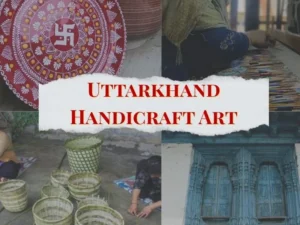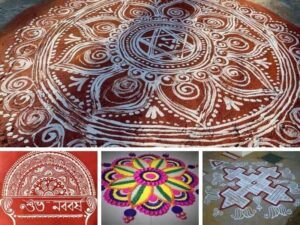Aipan Art (Aipan Kala) is a very rich and spiritual folk art of Uttarakhand’s Kumaoni culture. It is especially made on land, walls, temples, and platforms during auspicious occasions, festivals, and religious rituals. For this, a paste of rice powder (Biswar), geru (red ochre), turmeric, and roli is used.
This is not just a painting, but a tradition that has been passed down from mother to daughter for generations. Aipan is not only a decorative design, but it is also considered a medium of invoking deities and a source of positive energy.
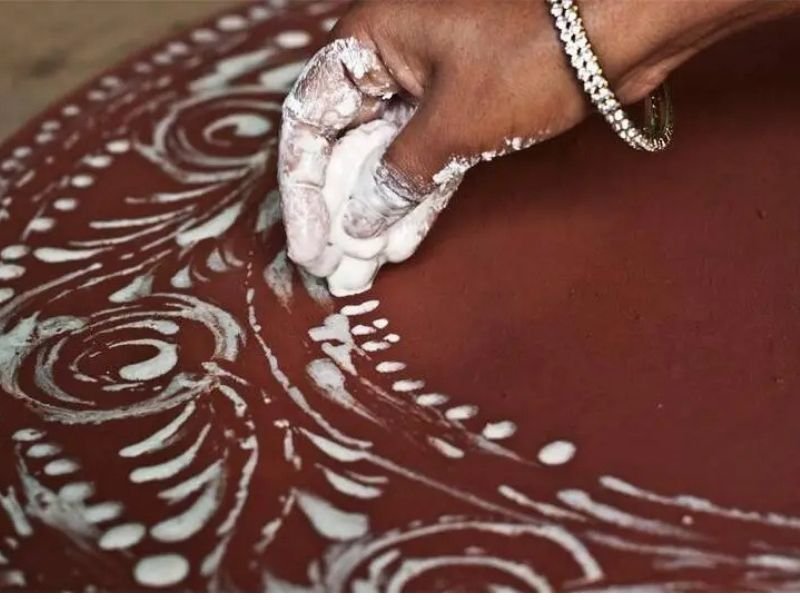
What is Aipan Art?
If we name one art form that represents the cultural identity of Uttarakhand, it is “Aipan Art.” This art usually consists of white geometric shapes, flowers, leaves, and religious symbols made with a rice paste (Biswar) on a red background (Geru). The purpose of these designs is auspiciousness, good wishes, and welcoming the deities.
Handcrafted arts of Uttarakhand like Aipan are popular all over India in different names and forms. In Bengal it is called Alpana, in Bihar Arichan, in Andhra Pradesh Bhuggul, in Gujarat Satiya, in Uttar Pradesh Chauk Pooran, in Rajasthan Mandana, and in South India Kolam. This shows how diverse and vibrant Indian folk art and cultural heritage are.
In today’s time, Aipan art is no longer limited to traditional homes and religious rituals, but has reached modern home décor, fashion, and digital design. The spiritual power and cultural importance of its traditional form are still as impactful as they were centuries ago.
What is Aipan Art? (Detailed)
The famous traditional folk art “Aipan,” also called Aipan or Alpana, is a traditional folk art of the Kumaon region of Uttarakhand, India. It has special importance in Kumaoni households because the word “Aipan” is derived from “Arpan,” which is usually associated with “writing” or “inscribing.” This art is especially popular in the Kumaon region and is made to decorate the ground, thresholds, and temples on auspicious occasions like worship, festivals, naming ceremonies, weddings, thread ceremonies (Janeu), etc.
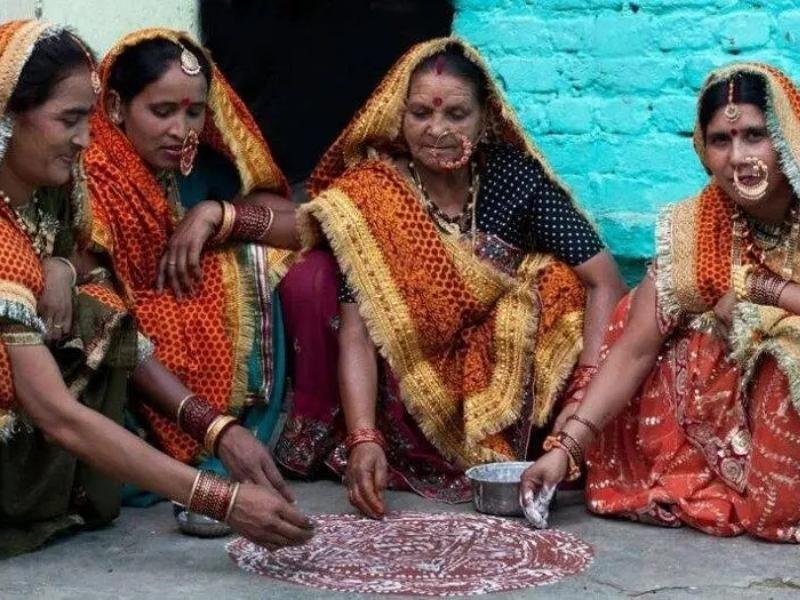
Aipan is mainly drawn with the help of fingers, using a paste of rice powder (Biswar), red ochre (Geru), turmeric, and roli. Its specialty is white geometric figures, flowers, leaves, and religious symbols made on a red background, which are considered symbols of auspiciousness, good wishes, and welcoming deities.
History and Tradition of Aipan Art
The history of Aipan Art goes back to mythological times. It is believed that this folk art was once a medium of worship and devotion to gods and goddesses in ancient times. For centuries in Uttarakhand’s Kumaon region, it has been a tradition to decorate the main doors of homes, temple walls, Tulsi Chauras, mortar-pestles, and havan kunds with Aipan designs.
Earlier, Geru and rice paste (Biswar) were used, but in today’s modern style, white and red oil paints or sticker Aipan are becoming common. Still, the spiritual power and cultural depth of the original art are just as powerful as in ancient times.
This art was never learned from formal institutions or books, but mothers taught it to their daughters at home. Through play and by helping, the tradition naturally passed from generation to generation.

In September 2021, this Kumaoni art received the Geographical Indication (GI) Tag. The GI tag will give recognition and economic benefit to traditional artisans and communities involved in creating Aipan art, while preserving and promoting their rich cultural heritage for future generations.
Dehlee Aipan – Welcoming Auspiciousness at the Doorstep
Dehlee Aipan, a beautiful part of Kumaoni tradition, not only decorates the threshold of the house but also makes it auspicious and sacred. It is also called “Dehlee Likhna” or “Dhei Likhna.” This tradition is so ancient that traces of it are also found in the ancient Yaksha culture.
The great poet Kalidas also mentioned it in his famous work Meghdoot, where a Yaksha from Himalaya’s Alkapuri says while describing his home:
“द्वारोपान्ते लिखितवपुषौ शंखपद्मौ च दृष्टवा”
(“By seeing the conch and lotus designs drawn by my wife at the doorstep, you will recognize my house.”)
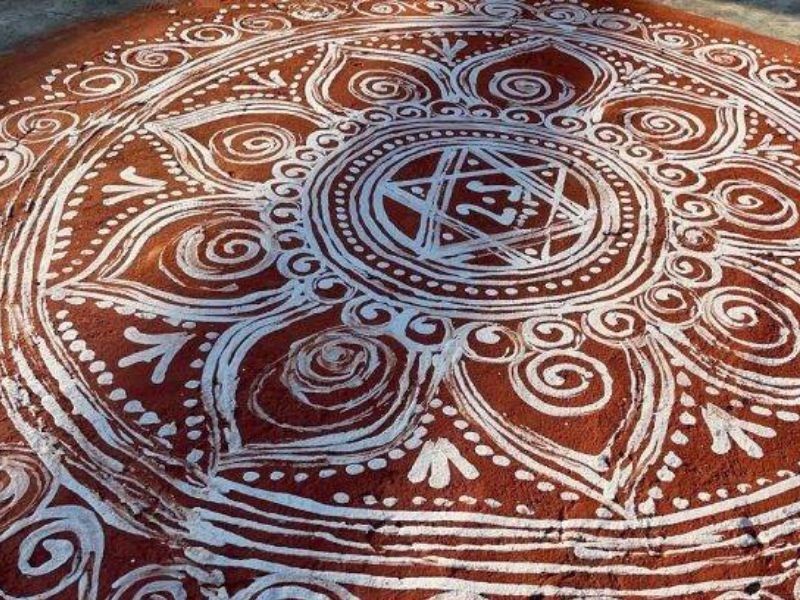
In Kumaon, no festival or religious ritual is complete without making Dehlee Aipan. In fact, “Dehlee Poojan” is celebrated as a separate festival for a whole month.
From Phool Sankranti to Vishuvat Sankranti (Bikhoti), housewives daily smear their thresholds with cow dung, mud, and Geru, and draw beautiful patterns with rice paste (Biswar).
Designs and Significance
Traditional designs of Dehlee Aipan include conch, lotus, swastik, ashtadal, and Lakshmi’s footprints, which are symbols of happiness, prosperity, positive energy, and divine blessings in the home.
Significance of Aipan Art
Aipan Art is not just decorative painting, but a symbol of faith, tradition, and spirituality. In Kumaon, Uttarakhand, it is believed that Aipan designs invite positive energy into the house and keep negative forces away. That is why it is especially made during auspicious occasions and religious rituals.
- Symbol of Auspiciousness and Good Wishes – Aipan designs are an essential part of welcoming and worshipping deities. The red background (Geru) symbolizes purity of the earth, while the white rice paste symbolizes cleanliness and purity.
- Spiritual Power – According to traditional belief, the geometric patterns and religious symbols of Aipan art help in meditation, devotion, and balancing energy.
- Cultural Identity – Aipan art is the soul of Kumaoni culture of Uttarakhand. It holds a prime place not only in homes but also in fairs, temples, and cultural events.
- Medium of Connecting Generations – Since this art is taught by mothers to daughters, it creates a deep bond between family and culture.
- Modern-Day Importance – Today, Aipan designs are not just limited to walls or courtyards, but are also used in home décor, clothes, handicrafts, and digital art, giving it global recognition.
Types of Aipan Art
In Aipan Art, different designs are made for different occasions, festivals, and religious rituals. Each design has its own religious, cultural, and spiritual significance. Below are some main types:
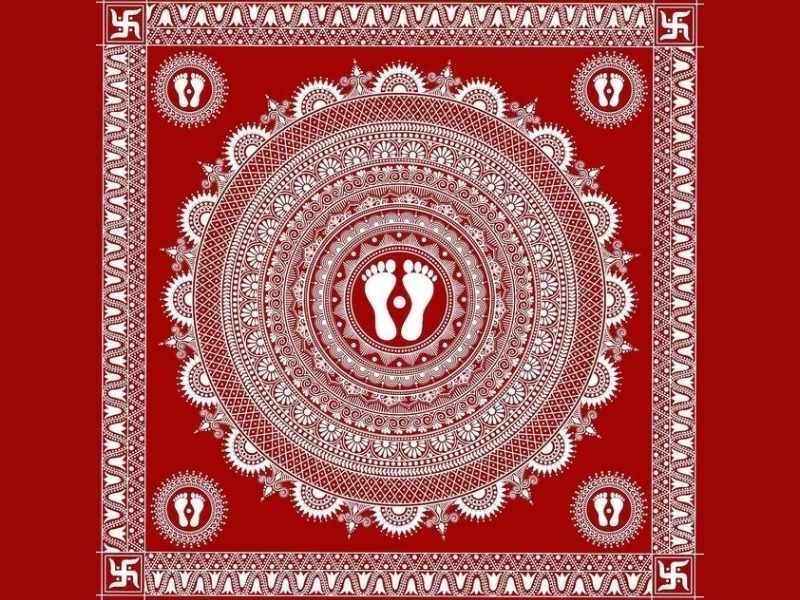
- Ashtadal (Eight-Petaled Lotus)
- Meaning – Ashtadal means a lotus with eight petals.
- Significance – This design is made as a seat for deities and symbolizes purity, knowledge, and prosperity.
- Occasions – Goddess worship, housewarming, weddings.
- Deep (Lamp)
- Meaning – Represents a lamp that removes darkness.
- Significance – Symbol of positive energy and knowledge.
- Occasions – Diwali, worship ceremonies, thread ceremony (Janeu).
- Dhuli Arghya
- Meaning – A ritual design offered by bride and groom to the Earth and deities during marriage.
- Significance – Represents the sanctity of marriage and good wishes.
- Chowki
- Meaning – A special square-shaped design where the place of deities is marked.
- Significance – Idols or pictures of deities are placed on the Chowki for worship.
- Occasions – Navdurga Puja, Sankranti, festivals.
- Saraswati Chowki
- Meaning – A special Chowki made for the worship of Goddess Saraswati, the deity of knowledge and learning.
- Significance – Invokes education, art, and wisdom.
- Occasions – Basant Panchami, a child’s first writing ceremony.
- Panchang
- Meaning – A design with five main symbols.
- Significance – Represents the five elements of life and balance.
- Lakshmi Pad (Footprints of Goddess Lakshmi)
- Meaning – The footprints of Goddess Lakshmi.
- Significance – Symbol of bringing wealth, happiness, and prosperity into the home.
- Occasions – Diwali, Ashtami, Dhanteras.
- Karva Chauth Aipan
- Meaning – A circular or square Aipan design made specially for the Karva Chauth fast, which includes moon, sieve, lamp, and Karva symbols.
- Significance – Symbol of blessings for the long life of the husband, marital happiness, and family prosperity.
- Occasions – On the day of Karva Chauth, before moonrise rituals.
Use of Aipan on Textiles
Aipan Art is not limited only to floors, walls, or worship spaces – it is also used on clothing.
In the Kumaon region, sacred Aipan symbols were hand-drawn on a traditional dupatta called Pichora. Women wore this garment on special occasions like weddings, naming ceremonies, or other auspicious events. It is considered a symbol of blessings and good fortune.
Over time, hand-made Pichoras have been replaced by printed ones, leading to a decline in traditional handcraft practice.
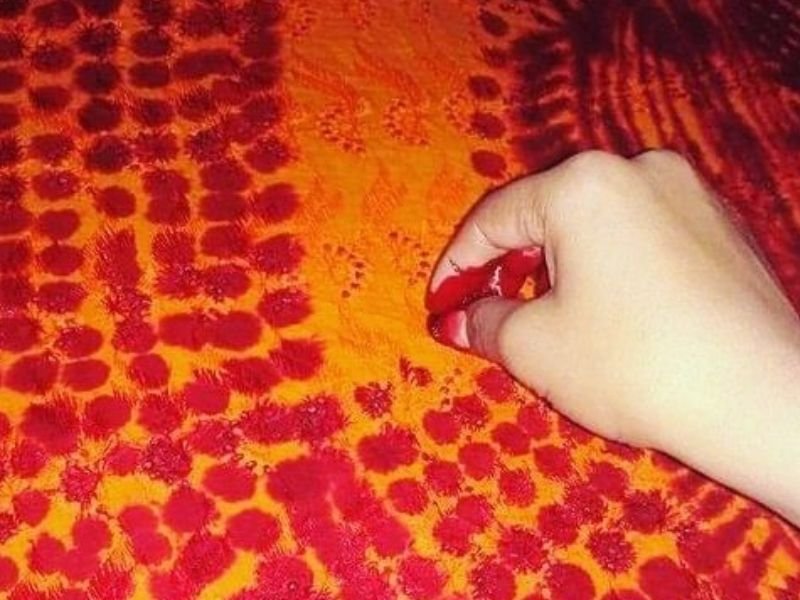
Modernization and Commercialization of Aipan
In today’s busy lifestyle, people lack time and patience, so traditional hand-drawn Aipan has been replaced by ready-made sticker Aipans, oil-painted designs, and digital print patterns.
These modern alternatives look attractive and are easy to apply, but they do not carry the spiritual energy, meditative power, and cultural depth of traditional Aipan.
The process of making traditional Aipan is not just art – it is also a form of meditation and spiritual connection, something machines and prints can never replicate.
Role of Influencers in Promoting Aipan Art
In the age of social media, influencers play a very important role in bringing traditional art to new audiences.
- Local Art Promotion – Uttarakhand’s local influencers include Aipan art in their content, making it trendy among youth.
- DIY & Workshop Content – Many influencers organize live sessions and workshops where people learn to make Aipan.
- Global Audience – Through social media, Aipan is reaching not only India but also international art and culture lovers.
- Brand Collaborations – Fashion, home décor, and handicraft brands collaborate with influencers to promote Aipan-designed products, giving economic benefit to local artists.
Influencers are not only keeping this art alive but also presenting it in a modern way, creating pride and interest for it among the younger generation.
Aipan and Spirituality – Journey from Fingers to the Divine
Aipan Art is not just decoration; it is a spiritual practice. The process of making it, its designs, and its colors are all connected to the mind, soul, and divine energy.
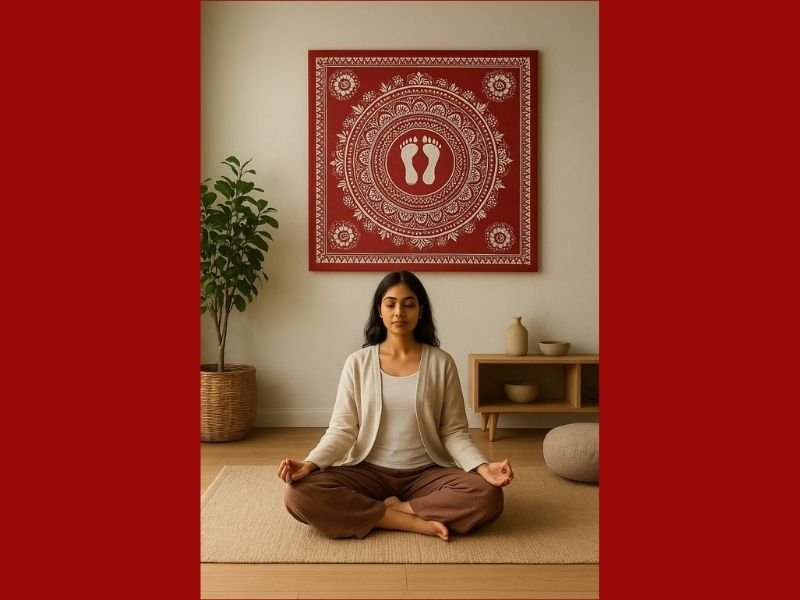
- Invocation of Energy – When the ground is smeared with Geru and designs are drawn with rice paste, the place becomes sacred and energized. Geru represents the earth element, and rice symbolizes purity and positive energy.
- Meditation and Peace of Mind – While making Aipan, the artist focuses completely on every line, shape, and dot. It is like meditation, where the mind stays in the present moment and negative thoughts fade away.
- Spiritual Meaning of Symbols –
- Ashtadal Lotus – Symbol of self-realization and purity.
- Swastik – Represents four directions and the cycle of creation.
- Lakshmi Pad – Invites happiness, prosperity, and spiritual wealth.
- Deep (Lamp) – Removes the darkness of ignorance and spreads the light of knowledge.
- Role in Rituals – Aipan is made during worship, weddings, thread ceremonies, Navdurga Puja, Karva Chauth, Sankranti, etc. It not only invites deities but also fills the atmosphere with positive energy.
- Spirituality in Modern Times – Today, through Instagram, YouTube, and online workshops, Aipan is no longer limited to villages and homes but is making its identity worldwide. Many people adopt it as therapy to reduce stress and find inner peace.
When an artist creates Aipan, their mind is not only on the design but also on the divine. That is why traditional Aipan carries a living energy and spiritual vibration, which can never be felt in machine-made sticker Aipan.
Aipan and Employment
Aipan Art is not just part of culture and tradition but has also become a strong medium of employment and self-reliance. Earlier limited to festivals and rituals, today it has opened new earning opportunities for youth and women through creative industries, e-commerce, and tourism.
- Medium of Women Empowerment –
Many women self-help groups (SHGs) in Uttarakhand are earning from home by making Aipan. Women design Aipan on clothes, home décor items, and gift hampers, and sell them in local fairs and online platforms. Campaigns like Pahadi Women Entrepreneurs are taking Aipan to national and international markets. - E-commerce and Online Business –
Aipan-designed products are sold on Amazon, Meesho, and Instagram Shops. People are also selling Aipan design digital prints, which customers use for wall art, t-shirts, posters, or greeting cards. - Income from Tourism and Cultural Programs –
Tourists visiting Uttarakhand take part in Aipan workshops, providing income to local artists. Live demonstrations and product sales also happen at handicraft fairs. - Business Ideas for Aipan Products –
- Fashion & Textiles: Sarees, kurtas, dupattas, scarves
- Home Décor: Cushion covers, table runners, wall hangings
- Gift Items: Diaries, calendars, keychains, mugs
- Art Installations: Decoration of cafés, hotels, and temples
- Earning from Global Market –
Handmade and eco-friendly art is in great demand abroad, so Aipan products are being exported. Aipan patterns are also being sold as NFTs and digital art internationally.
Conclusion
Aipan Art is not just a traditional painting but a symbol of culture, faith, and self-reliance.
In today’s time, this art is not limited to the thresholds of homes and temples but is also creating its identity in fashion, home décor, and the international market.
Aipankari works with this vision – to bring traditional Aipan Art to the world through modern designs, products, and platforms. Our aim is that this art should not remain just a form of decoration but also become a source of livelihood and identity for artists.
With proper planning, modern marketing, and focus on quality, Aipan Art can generate annual income worth lakhs of rupees. Aipankari is moving forward in this direction, so that our mountain heritage remains alive for future generations and earns a place on the global stage.
Aipankari – Tradition and Identity Together.
FAQ’s
What is Aipan Art?
Aipan Art is a traditional folk painting of Uttarakhand, created using white paste on red backgrounds, symbolizing prosperity and rituals.
What is the significance of Aipan Art?
Aipan Art is believed to bring good fortune, spiritual protection, and is an important part of cultural rituals and festivals in Uttarakhand.
Who makes Aipan Art?
Traditionally, Aipan is created by women of the Kumaon region, using rice paste to draw sacred designs on floors and walls.
Where is Aipan Art found?
Aipan Art is mainly practiced in Uttarakhand, especially in the Kumaon region, and is often seen in temples, homes, and cultural ceremonies.

